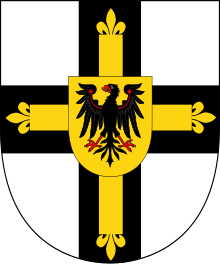Grand Masters of the Teutonic Order
| Grandmaster of Teutonic Order Hochmeister |
|
|---|---|

The seal of the Grand Master of the Teutonic Order (Sigillum Magistri Generalis Hospitalis Sancte Marie Theutonicorum Ier(oso)l(o)m(i)tan(i). This seal was in use for more than 200 years, from the 13th century until it was replaced by Frederick, Duke of Saxony in 1498.
|
|
| Reports to | Holy See |
| Term length | Life tenure |
| First holder | 1219 |
The Grand Master (German: Hochmeister; Latin: Magister generalis) is the holder of the supreme office of the Teutonic Order. It is equivalent to the grand master of other military orders and the superior general in non-military Roman Catholic religious orders. Hochmeister, literally "high master", is only used in reference to the Teutonic Order, as Großmeister ("grand master") is used in German to refer to the leaders of other orders of knighthood.
An early version of the full title in Latin was Magister Hospitalis Sanctae Mariae Alemannorum Hierosolymitani. Since 1216, the full title Magister Hospitalis Domus Sanctae Mariae Teutonicorum Hierosolymitani ("Master of the Hospital House of the Blessed Virgin Mary of the Germans of Jerusalem") was used.
The offices of Hochmeister and Deutschmeister (Magister Germaniae) were united in 1525. The title of Magister Germaniae had been introduced in 1219 as the head of the bailiwicks in the Holy Roman Empire, from 1381 also those in Italy, raised to the rank of a prince of the Holy Roman Empire in 1494, but merged with the office of grand master under Walter von Cronberg in 1525, from which time the head of the order had the title of Hoch- und Deutschmeister.
The coat of arms representing the grand master (Deutschmeisterwappen) is shown with a golden cross fleury or cross potent superimposed on the black cross, with the imperial eagle as a central inescutcheon. The golden cross fleury overlaid on the black cross becomes widely used in the 15th century. A legendary account attributes its introduction to Louis IX of France, who on 20 August 1250 granted the master of the order this cross as a variation of the Jerusalem cross, with the fleur-de-lis symbol attached to each arm. While this legendary account cannot be traced back further than the early modern period (Christoph Hartknoch, 1684) there is some evidence that the design does indeed date to the mid 13th century.
...
Wikipedia

